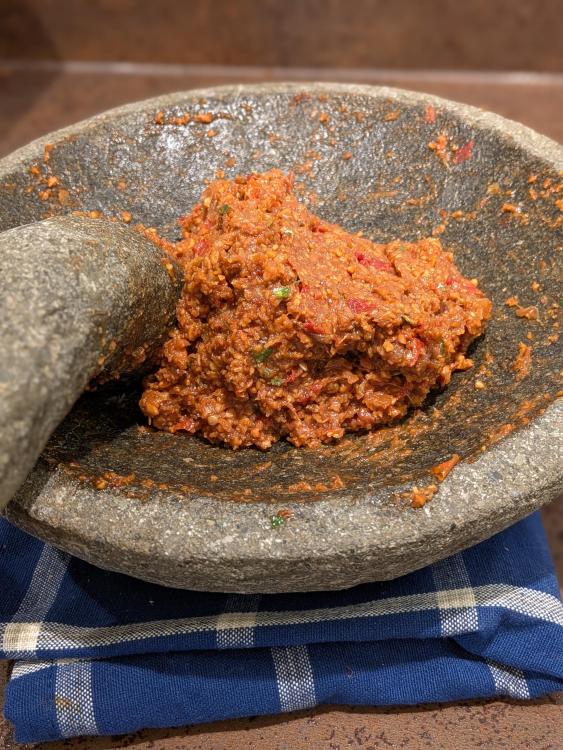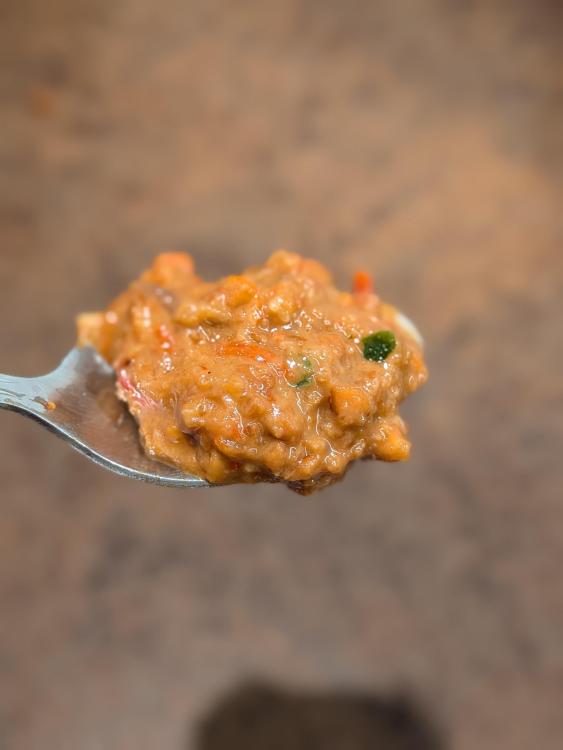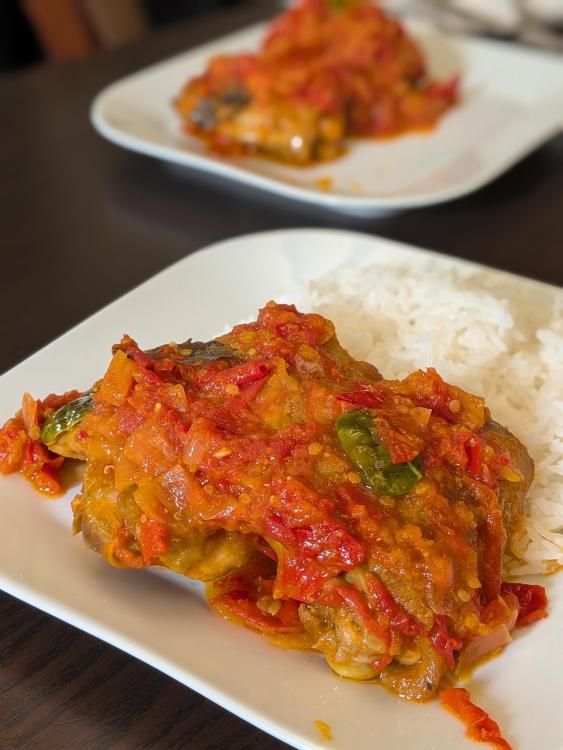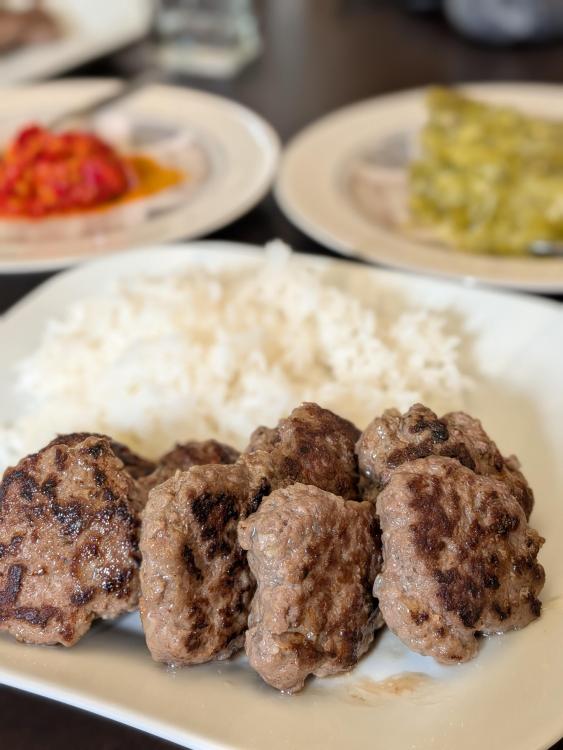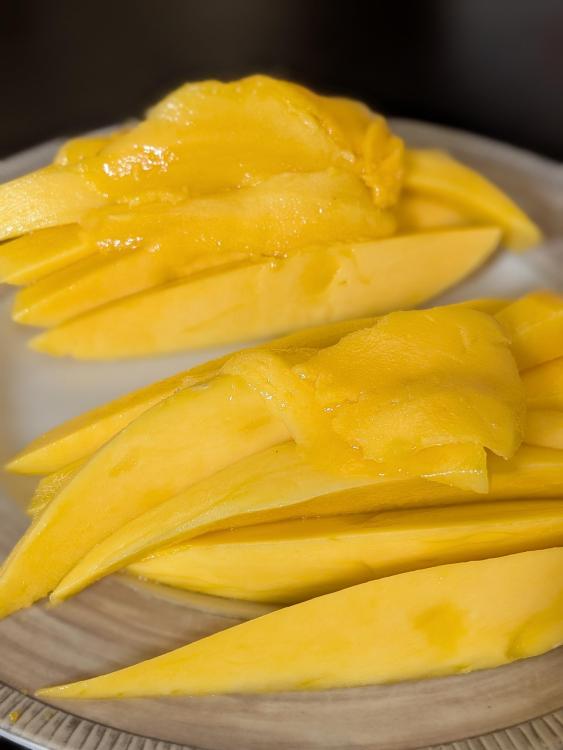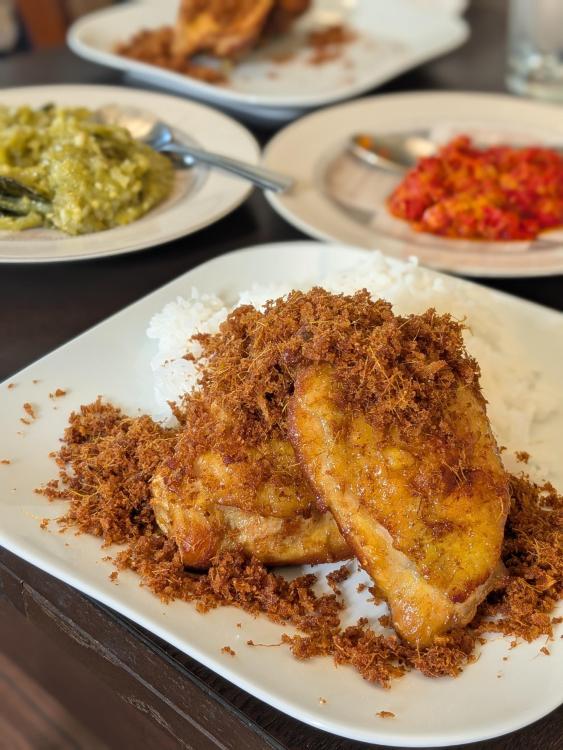
KennethT
participating member-
Posts
6,843 -
Joined
-
Last visited
Content Type
Profiles
Forums
Store
Help Articles
Everything posted by KennethT
-
Is it analogous to presalting a chicken or steak? I'm thinking about meaty chunks of grouper, tuna, swordfish, etc....
-
That place is awesome! I've had some great conversations with the owner. She wants me to sell her some of my kencur and home grown Indonesian chillies. As far as I know, they don't carry the beef skin crackers (I've looked for them before) but they do have pre-fried shrimp crackers and some other krupuk (they look like shrinky-dinks).
-
ooof, that's a shlep!
-
Interestingly, I think the kulit in krupuk kulit means leather also...In many parts of Java, a shadow puppet show called wayang kulit is very traditional. The puppets are made from leather and the shows typically depict a portion of, or sometimes the whole, Ramayana (which is really long) and is accompanied by a full gamelan orchestra.
-
Thanks everybody. I didn't think of Ottomanelli - I used to go there all the time but haven't in years. When I clicked on the Mercato link, it looked like it was coming from Ideal foods in Brooklyn... I think my first stop should be at a couple meat markets in Chinatown. I've never bought from Ends Meat but they probably would be a good resource since they deal with whole animals.
-
I've been thinking about making krupuk kulit - the unbelievably delicious and addictive puffed beef skin cracker common in Java (Indonesia) but have no idea where to get the fresh beef skin. Ideally, it's made from the softer, "inner skin" but I'm not even sure what that means.... I've looked at the Weee online grocer with no luck. I'd think Chinatown may have it, but I'd assume they have more pork products than beef ones... curious for any suggestions... Thanks!
-
I think the biggest problem with a fast release while braising would be the homogenization of the liquid fat (that has rendered out of the beef and would normally be floating on top) into the braising liquid.
-
What region is your tabbouli from? It has a lot more bulghur in it than I usually see. The Iraqi version my friend's mom used to make as well as the Jewish Moroccan version I've had have almost no bulghur by comparison - they're mostly green.
-
Now, see the new and improved version !!!!
- 1 reply
-
- 1
-

-
This is the new and improved version of sambal kacang - Indonesian peanut sauce. It could also be called sambal pecel - pecel is a vegetable dish consisting of bland, boiled leafy vegetables served with this type of peanut sauce, similar to the more famous gado gado, but without the tempeh, tofu, etc. This is a traditional version, meaning that it's quite labor intensive and is made from all whole ingredients. Makes.... a LOT - multiple portions! This recipe is for the base, which you would thin with boiling water to the consistency you want. The reason for this is that the base is very dry and will last a long time - a couple of weeks at room temp or several months in the refrigerator. When you want some, just take a few spoonfuls and thin with boiling water until you have the quantity and consistency you're looking for. Ingredients: 200g raw peanuts (deskinned) 60g red chillies - mostly keriting (medium spicy) and a few rawit (very spicy) 125g shallots (about 8 small shallots or 3-4 Western shallots) - skin and ends removed 20g garlic (peeled, end removed, halved and germ removed if exists) 4-8 kaffir lime leaves, destemmed (size dependent) 11.4g roasted shrimp paste - 3 sachets ABC brand (3.8g each) 1C (approx.) peanut oil 60g palm sugar, grated or chopped finely 1T salt (plus more to taste) 1t MSG 1t seedless tamarind paste Instructions: 1) cook the whole chillies in a pan of boiling water until soft - about 5 minutes, drain 2) heat the oil in a wok over medium/low heat and fry the shallots until softened and slightly brown 3) remove/drain the shallots, repeat with the garlic 4) remove/drain the garlic and fry the lime leaves for a minute or so, then remove/drain 5) fry the peanuts in the oil, stirring constantly, until just less than golden brown, then remove/drain 6) In a food processor, roughly chop the chillies/shallots/garlic/lime leaves/shrimp paste, remove and set aside 7) Roughly chop the fried peanuts 8 ) Move the chilli/shallot, etc mixture to an Indonesian mortar (cobek), add the tamarind, salt, MSG and palm sugar then grind until smooth as possible 9) Add the peanuts to the mixture and continue to grind - the paste will become very stiff and dry as it cools To check seasoning, add a little bit of boiling water to a teaspoon or so of ground mixture and mix until you have the desired consistency
-
- 8
-

-

-

-
Another entry in the Most-Labor-Intensive dish contest, also from the Padang food canon... This one is ayam balado - chicken in balado sauce. You can balado-ify practically anything - chicken, eggs, potatoes, beef, fish, you name it. What qualifies it for a contender in the MLI contest? First, the chicken is braised in a ground spice paste liquid containing garlic, turmeric, candlenuts, ginger, kaffir lime leaves, etc... The chicken is removed and some of the braising liquid retained. The chicken is then shallow fried in oil, and then removed and drained, and then, in the same oil, a ground mixture of chillies and shallots (preferably ground by hand) and sliced tomatoes are fried with some lime juice, the reserved braising liquid and more kaffir lime leaves added. The result is super savory but refreshing at the same time... one of my favorites!!!
-
I've never heard of pressure cooking the curry base so I'm very curious about it. How do you think it compares with being simmered traditionally? Most videos I watch making Indian curries (from India) don't cook the curry base very long - probably around the same time as your pressure cooking it. Do you think the result is superior? If so, in what way?
-
I made this again today and I think it came out even better - the only change was that instead of using all 250g of keriting chillies, I used 3 big red chillies, 3 of my home grown cabe rawit (kind of like Thai chillies but more plump) and the balance of the 250g being the keriting.
- 1 reply
-
- 3
-

-

-
Red Boat 40degN - it's a brand of Vietnamese fish sauce. The 40 degrees indicates the degrees of Nitrogen.
-
What's the purpose of the half and half?
-
The biggest issue I see is the fact that they treated each variety the same. Silkies, for example, would never be pan roasted like that!!!! That's not the point of using one. You use silkies for the broth they make. They would have been more ridiculous if they tested a SE Asian "kampung" chicken that way - they probably wouldn't even be able to cut through the joint. Kampung chickens need to be simmered until tender, which can take like 40 minutes to an hour! Eating a pan roasted one would be like eating a rubber band, but when cooked the way they're supposed to are super flavorful.
-
When I make some kind of traditional chicken curry for a dinner party, I make the chicken curry traditionally - usually at least the week before if not even more, then once finished, I transfer everything to a zip lock bag, then hold in the waterbath at like 160F until pasteurized. Then, I quick chill and put the bag in the fridge where it can safely keep for at least 3 weeks. Then, I'll reheat in the waterbath at like 140F or sometimes I'll set the bath to 130 and leave it in there longer so I don't have to worry whether it's fully reheated or not. This way, the curry is at the texture I'd want traditionally, the chicken is fully but not overcooked, and it was all done long ago so no stress.... I'm actually planning to do some of that this weekend as we're having people over on the 25th....
-
What do you mean by "changes the texture just a bit" - changes in what way? After the soak, do you rub with oil or anything before the air fryer?
-
We also had a 5'x5'x7' grow tent!
-
I've never experienced the rotten potato smell, but this reminds me to say that I will never again leave a bag of frozen shrimp out on top of the freezer (which was in the middle of our living room)... We walked in one day and thought that there was a dead rat hidden in the walls, which would have been impossible in our 21st floor, poured concrete and steel apartment!
-
Indonesian style bison patties with the last of my sambal ijo and sambal merah. I know what I'm doing next weekend.... Also, one of the last late season mangoes... But good news, we got some green mangoes!!
-
I would go back to Hong Kong just for more roast goose....
-
This installment of Extremely Labor Intensive Padang Food is one of my favorites - fried chicken. In my opinion, this, with all of the accoutrements, is vastly superior to the vaunted Thai Hat Yai fried chicken. The steps are essentially as follows - grind a spice paste out of fresh ingredients, simmer/braise the chicken in the spice paste with as much water as to partially submerge the chicken, remove the chicken once tender (traditionally, you'd use "kampung" or village chickens which tend to be quite tough) and then separately remove all of the solids from the braising liquid with a very fine mesh strainer, then shallow fry the braised chicken and then fry the solids. Serve with even more labor intensive sambals... The good thing is that it doesn't all have to be done at the same time. The sambals can be done well in advance - some people even store them at room temperature for a few weeks (I portion and freeze them as I'm not THAT confident that they won't go bad and ruin all that work as well as my evening/next day), the chicken can be braised earlier that day or a few days before and fried at the last minute and the spice paste, once fried, will keep forever as long as it is kept dry (I keep it in an airtight plastic container with paper towels above and below to absorb excess oil and I add a couple of desiccant packets between the upper paper towel and the cover). Just to make things a little more complicated, you can make variations of the serundeng (that's the fried spice paste) by varying the ratio of ingredients. Personally, my favorite is the galangal heavy version which is detailed below, but you can easily make it a candlenut heavy version by practically eliminating the galangal (just use a little bit then) and using a metric ton of candlenuts (around the same volume as the galangal would have been). Or you can make a ginger heavy version or an extra shallot-y version... It's all up to your personal preference. Usually, in a Padang restaurant, they serve only one kind which they won't tell you what it is unless you specifically ask so it's a fun surprise. Truth be told, once the frying is all done, all of the serundeng are remarkably similar tasting - the differences are there, but are much more subtle than you'd expect them to be. Yield 4-8 chicken thighs - if only 4, you'll have a LOT of extra serundeng Spice paste (bumbu): Shallots - 3 western size or 8 of the smaller Asian ones (about 150g) Galangal - about the same volume as the shallots or maybe a bit more Garlic - 6 large cloves Fresh turmeric - roughly 4" long, 3/4 - 1" diameter Ginger - about 1/4 of the shallot volume Candlenuts - 3 pieces Ground dried coriander - 1 heaping Tablespoon Ground black peppercorn = 1 teaspoon Water to almost cover the chicken 2 large daun salam (Indonesian bay leaves, very different from Turkish or California bay) 6 kaffir lime leaves 1 stalk lemongrass Seasoning: 1/2t MSG 1/2t chicken powder 1-2t salt (to taste) 1/2t sugar Grated coconut (fresh or frozen) - unsweetened - about the same volume as the shallots Oil for frying - I like peanut oil but you can use canola oil, corn oil or any relatively high temperature oil 1) Grind the spice paste (bumbu) in a blender with some water to help it blend, or if you want to make it even more labor intensive, use a mortar/pestle 2) In a cold wok or pan just large enough to hold the chicken close together, add the blended spice paste, water, leaves/lemongrass, seasoning and chicken, mixing to combine thoroughly and bring to a gentle boil over medium-high heat, stirring occasionally 3) Sprinkle the coconut on top and mix in thoroughly, turn the heat to low, cover and simmer until tender/cooked thoroughly, turning and stirring occasionally, scraping the bottom to make sure nothing settles/burns 4) Remove the chicken and set aside on a rack to drain well (this will minimize spattering later), also remove the lemongrass/leaves and discard 5) Using a fine mesh strainer, remove the solids from the braising liquid, then press to remove as much liquid as possible 6) In a clean wok or pot, add enough oil to shallow fry the chicken and bring to 350degF 7) Fry the chicken in batches until golden brown on both sides, then remove and drain on a rack or paper towels, removing any loose serundeng between batches to avoid burning 8 ) Bring the oil back up to temperature and add the drained solids (slowly so it doesn't explode) and stir constantly to keep from burning 9) Once golden brown, remove the fried solids with a fine mesh strainer and drain well, then spread on a couple layers of paper towel to absorb any excess oil Serve with jasmine rice, sambal ijo and sambal merah, putting a healthy pile of the serundeng on top of the chicken:
-
- 11
-

-

-

-
Right... but I guess my point was that the Murray's cheese sold in the NYC stores are probably still aged in-house, but who knows about the product they sell through Krogers or elsewhere in their expansion.

